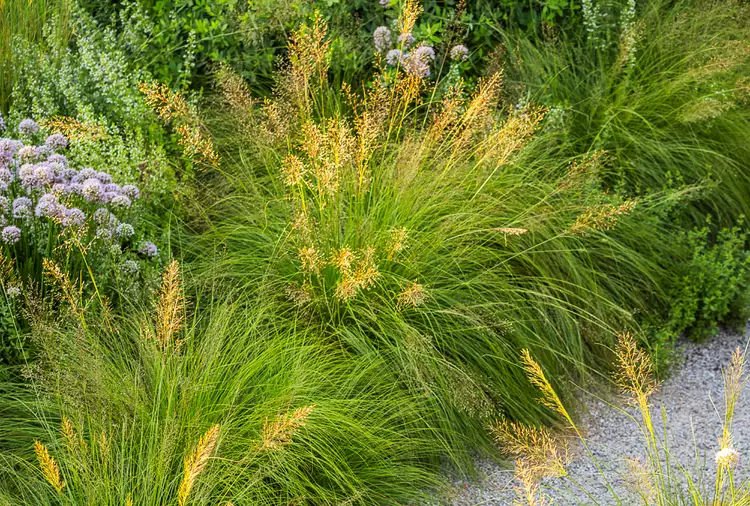Planted in small groups or in masses, prairie dropseed brings a hint of the prairie to your garden. With a mounding habit, the billowy light green leaves in summer also add a soft texture to the landscape. The leaves turn golden or orange in fall, then change to coppery brown in winter. Flower panicles appear above the foliage on slender stems in late summer. Sometimes, a scent of popcorn surrounds the plant at this time of year.
As a native plant, prairie dropseed attracts pollinators and birds. The birds eat from the seed heads and can be observed hopping around the plants and garden looking for food and cover. As a “go-to” small native ornamental grass, this plant's good looks and easy-care nature often inspire gardeners to try growing even more ornamental grass species.
Prairie Dropseed Overview
| Genus Name | Sporobolus heterolepis |
| Common Name | Prairie Dropseed |
| Plant Type | Perennial |
| Light | Part Sun, Sun |
| Height | 2 to 3 feet |
| Width | 1 to 2 feet |
| Foliage Color | Blue/Green |
| Season Features | Colorful Fall Foliage |
| Special Features | Attracts Birds, Low Maintenance |
| Zones | 3, 4, 5, 6, 7, 8, 9 |
| Propagation | Division, Seed |
| Problem Solvers | Deer Resistant |
Where to Plant Prairie Dropseed
This deer-resistant plant thrives in a wide range of gardens in USDA Hardiness Zones 3-9. Plant it in garden beds, along paths, and in native habitat gardens. Use prairie dropseed in perennial gardens with blooming plants of any color beside this plant. Repeat groupings throughout your landscape, using bright colorful flowers with the group of grasses to give the design a cohesive feel. The grass planted in a row along sidewalks and paths brings a sense of order to your landscape.
When and How to Plant Prairie Dropseed
Planting prairie dropseed in the fall is often your best bet. Native plants tend to show growth later than some garden plants, so garden centers may not have them available in the spring or early summer. However, prairie dropseed is a hardy native grass that may be planted whenever the ground is workable. Plant at the depth grown in the pot. When planting a group of these grasses, space 18 inches to 2 feet apart.
Care Tips
Just place prairie dropseed in a sunny location, and keep it watered the first year and in periods of drought. After that you won't need to do much more than cut the dead leaves off in early spring to make way for new growth. Cut back to 4 inches in early spring. Fertilization is not necessary.
Light
Choose a spot in full sun (at least 8 hours of direct sunlight).
Soil and Water
Plant in well-drained soil. Apply supplemental water the first year. It adapts to periods of wet soil such as on the sides of a rain garden but is drought-tolerant.
Pests and Problems
Pests tend to leave this plant alone. Like all grasses, the center eventually does not send out new growth. Lift the clump and divide the plant, discarding the old center. Replant one piece in the same location and the rest in another location.
Types of Prairie Dropseed
'Tara'
This dwarf prairie dropseed variety has a smaller, more upright stature and heavier bloom set than the species. 'Tara' also tends to be more uniform. The foliage turns rust red in the fall. It grows up to 3 feet tall and about a foot wide. Zones 4-7
Prairie Dropseed Companion Plants
Butterfly Weed
A native plant, butterfly weed (Asclepias tuberosa) is a type of milkweed with a bright orange flowers in summer. This plant is often late to emerge in spring so be careful not to weed it out. Plants in the Asclepias genus provide food for the larvae (caterpillars) of the monarch butterfly. This small to medium size prairie perennial works well with native grasses and in perennial gardens in Zones 3-9.
Perennial Salvia
Choose a perennial salvia (Salvia nemorosa) variety in hues of purple, blue, and pink. They grow from 8 to 24 inches tall and wide and are deer resistant. After they have finished blooming in early summer, cut them back to just above the crowns to encourage them to bloom again. Two favorite varieties are purple 'Caradonna' and pink 'Rose Wine'.




















